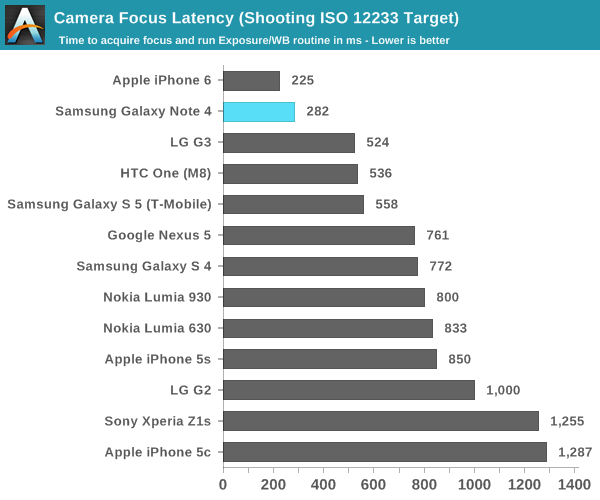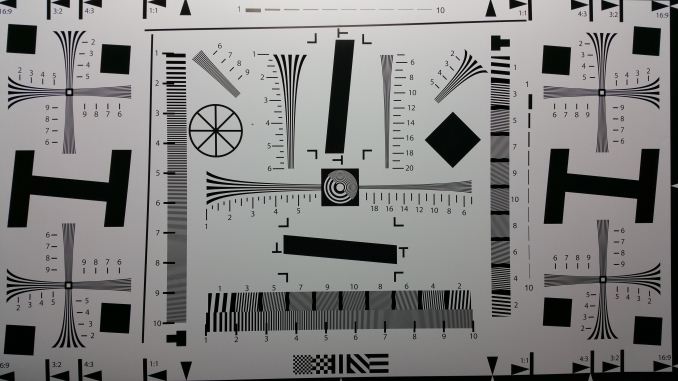The Samsung Galaxy Note 4 Review
by Joshua Ho on October 15, 2014 9:00 AM EST- Posted in
- Smartphones
- Samsung
- Android
- Mobile
- Galaxy Note 4
Camera
While the 16MP camera of the Galaxy Note 4 is mostly what we would expect, Samsung has really changed things up with the addition of OIS. Outside of this addition and the Sony IMX240 sensor, there’s really not a lot of change when it comes to the Galaxy Note 4. This means that we see the same 31mm equivalent focal length and F/2.27 aperture. At this point, it seems that OIS has finally reached mainstream adoption as both Samsung and Apple are shipping OIS solutions on their phones. The front facing camera is noticeably different though, with a Samsung S5K6D1YX sensor that I haven't seen elsewhere.
However, before we get into the proper image quality analysis I wanted to first cover shot to shot latency and focus/AE latency, as both are critical to a good image capture experience. Even if it’s possible to get amazing photos from a camera, it doesn’t really matter if the moment is missed. In order to test this, we look at the ideal case, which is when the phone is pointed at the ISO chart with bright lighting to maximize contrast.


As one can see in the graphs above, capture latency and focus latency are quite competitive with on the Note 4. However, there is one crucial detail that the focus latency graph misses, which is that Samsung doesn’t have continuous auto-focus in preview with the Note 4. As a result, there’s realistically an additional latency period before the auto-focus begins to run. The result is that the total time from out of focus to in focus is realistically closer to 800ms, but if one immediately taps the display to begin an AF run it’s possible to achieve the lower bound value, which is just south of 300ms.
Still Image Performance
While I'm still working on moving towards a better test for cameras, for now we have our standard photo comparisons that should give a good idea of what to expect from a smartphone camera in comparison to other cameras. Our first test is the standard ISO chart, which allows for a good test of maximum resolution.

For this first test, it seems that Samsung hasn't really changed much when it comes to maximum resolution, and in general the Note 4 produces similar output to the Galaxy S5. To verify this and a test of dynamic range, we'll look at a landscape shot next.
In this test, we see that the Galaxy Note 4 generally does well with detail and dynamic range as the landscape is generally well-detailed, although there's quite a bit of detail that seems to be smudged away on the grass as it seems to be a flat green texture for the most part. There's also noticeable color artifacting on the bleachers in the distance. We'll look at the same scene in low light to get a better idea for what the Note 4 really brings to the table.
Here, in low light we see significant improvements in image quality when comparing the Galaxy S5 to the Galaxy Note 4. The iPhone 6 Plus and Note 4 are quite close in overal quality, but looking at the brick building on the right of the image shows that the iPhone 6 Plus is maintaining a higher level of detail in this scene.
In the case of HDR, Samsung continues to do a great job with their implementation. For the most part this feature is successfully implemented with no real halos or other artifacts even when there are moving objects in the shot. This is likely to be implemented through on-sensor HDR rather than image combination.





































195 Comments
View All Comments
theduckofdeath - Wednesday, October 15, 2014 - link
I think this is a US centric site and the Exynos variant will probably never be on sale in the US.gunsman - Wednesday, October 15, 2014 - link
Will you guys be getting the international version of this as well? Would love to see performance of A57/A53 compared to the 805. Would also love to see comparison of ARMv7 A57/A53 to (when it comes out) ARMv8 enabled A57/A53 to see benefits of new instruction sets and 64 bitmayankleoboy1 - Wednesday, October 15, 2014 - link
thisMost important think about the Note4 is the Exynos 5433 SOC, which is on the 20nm node. Snapdragon 805 is a known entity.
mpokwsths - Wednesday, October 15, 2014 - link
@JoshHo: You do know that the NAND performance measurements and comparisons between different OS and benchmark programs is not accurate, right? I own a Nexus 5 which, with Android L preview, achieves more than double the performance figures than with Kitkat. That same has been observed with other Android L devices: http://forum.xda-developers.com/nexus-7-2013/gener...I'm saying this because of the misleading graphs you provide, showing the iphones miles ahead of Kitkat android devices. Well, they are NOT. They are just on a different OS / benchmark. Iphones should be removed from the graph ASAP, or include some Android L preview measurements as well. Otherwise, the NAND performance graphs are highly misleading.
JoshHo - Wednesday, October 15, 2014 - link
I don't have any particular reason to suspect Androbench pre-Android L, but I would expect some sort of compatibility issue with Androbench and Android L dev preview.NAND performance is generally not OS-dependent.
mpokwsths - Wednesday, October 15, 2014 - link
OS AND bench programI would expect a great amount of optimizations in the fs layer / kernel i/o scheduler and caching departments, together with newer controller device drivers of Android L. To make things simple: What if the compatibility issue of Androbench is with Kitkat and only with Android L will the true performance numbers show?
We will know soon enough...
Ortanon - Wednesday, October 15, 2014 - link
LOL What are you talking about? The Galaxy Note 4 is a package of hardware and software. Your Nexus 5 has Android L Preview on it; The Galaxy Note 4 does not. It gets the benchmark rating that it gets, and the iPhone gets the rating that it gets.mpokwsths - Wednesday, October 15, 2014 - link
whatever....uhuznaa - Wednesday, October 15, 2014 - link
What's wrong with testing devices with the OS that they're actually delivered with? After all it's the performance you'll see in actual use.KPOM - Wednesday, October 15, 2014 - link
We all know that the first thing the average consumer does is root the phone and install a bootleg version of the OS.